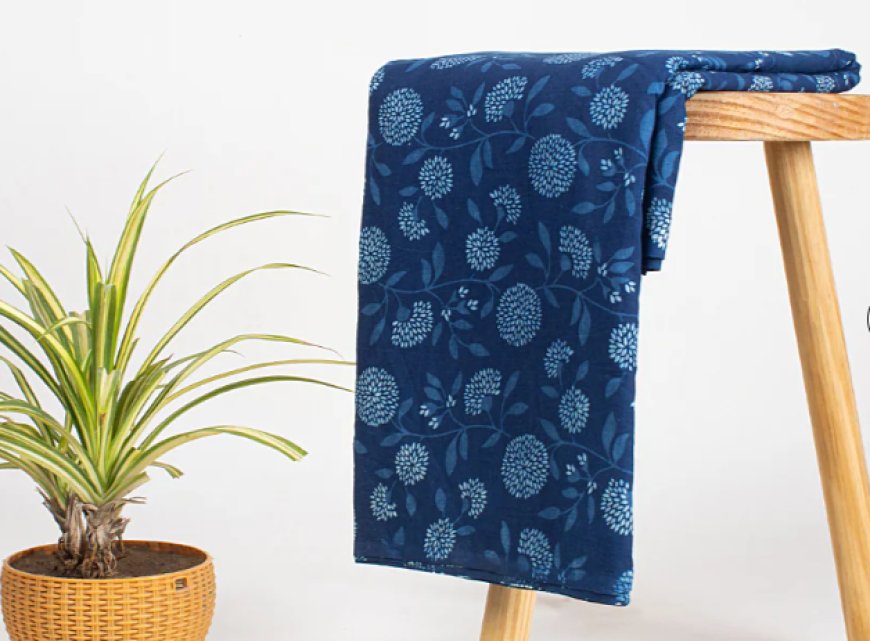Indigo Print Fabric: A Timeless Craft Rooted in Tradition and Style
Indigo print fabric stands at the intersection of tradition, sustainability, and global style. Its enduring beauty, deep cultural roots.

Indigo print fabric is one of the oldest and most iconic textiles in the world, prized for its rich blue hues, natural dyeing process, and handcrafted artistry. From ancient civilisations to today’s sustainable fashion, indigo print fabric has maintained its status as a symbol of heritage, elegance, and eco-conscious living. We invite you to explore the depth, texture, and cultural value of this extraordinary fabric that continues to shape modern design and ethical fashion.
The Origins and History of Indigo Print Fabric
Indigo dyeing has a legacy that dates back over 5,000 years, with deep roots in Africa, Asia, and the Middle East. In India, the Indus Valley Civilisation was one of the first to cultivate Indigofera tinctoria, the plant from which natural indigo is extracted. Over centuries, the technique evolved into elaborate hand block printing traditions in regions like Rajasthan and Gujarat.
Indigo’s journey from ancient dye pits to global textile markets is a story of cultural exchange, colonial trade, and resistance. During the British Raj, indigo became a cash crop, but the exploitative system led to the famous Champaran Satyagraha led by Mahatma Gandhi. Today, artisans reclaim this dye with pride, using it in organic, sustainable, and ethical textile production.
What Makes Indigo Print Fabric Unique
1. Deep, Vibrant Hues
Indigo is known for its signature deep blue tones that evolve beautifully over time. Unlike synthetic dyes, natural indigo ages gracefully, developing character and richness with each wash. Its cool undertone makes it suitable for a range of designs—from classic to contemporary.
2. All-Natural and Eco-Friendly
Natural indigo is derived through a fermentation process from the indigo plant. This makes it biodegradable, non-toxic, and gentle on the skin. The dyeing process consumes less water and avoids harmful chemicals, making indigo print fabric a key player in the slow fashion movement.
3. Handcrafted with Precision
The beauty of indigo lies not only in the colour but also in the traditional methods of application:
-
Dabu Printing: A mud-resist technique used in Rajasthan to create intricate motifs.
-
Bagru and Sanganeri Block Printing: Involves hand-carved wooden blocks dipped in indigo for bold, geometric, and floral designs.
-
Tie-Dye and Shibori: Techniques that create beautiful patterns through folding, twisting, and binding fabric before dyeing.
Each piece of indigo print fabric is unique, shaped by the hands of skilled artisans and influenced by local cultural expressions.
The Process of Creating Indigo Print Fabric
1. Preparing the Fabric
Cotton or silk is typically used for indigo prints. The fabric is pre-washed and treated with Harda (myrobalan) to prepare it for dyeing, which ensures that the colour binds well and remains vibrant.
2. Printing or Resisting
Designs are applied using wooden blocks, screen printing, or resist methods like wax (batik) or mud (dabu). This step is critical for defining the final pattern.
3. Indigo Dyeing
Fabrics are dipped into indigo vats. Unlike other dyes, indigo oxidises in air, so the blue colour develops only after the fabric is pulled from the vat and exposed to oxygen. Multiple dips deepen the hue.
4. Washing and Finishing
Once the desired colour is achieved, the fabric is washed to remove excess dye and then sun-dried. The result is a breathable, soft fabric with a luxurious hand feel.
Popular Designs and Motifs in Indigo Print Fabric
-
Paisley (Mango or Kairi): Symbolises fertility and abundance.
-
Floral Vine Patterns: Inspired by Mughal gardens, these are graceful and timeless.
-
Geometric Grids and Dots: Reflect symmetry and minimalism, often used in modern apparel.
-
Animal and Nature Motifs: Peacocks, elephants, leaves, and stars are common in rural and tribal indigo prints.
These designs are often infused with regional symbolism, showcasing India’s cultural diversity and storytelling tradition.
Uses of Indigo Print Fabric in Fashion and Interiors
1. Apparel
Indigo prints are widely used in ethnic and Western wear:
-
Kurtis, sarees, and dupattas offer effortless elegance.
-
Bohemian maxi dresses, tunics, and palazzos are staples in eco-conscious wardrobes.
-
Menswear like shirts and jackets use bold indigo patterns for contemporary appeal.
2. Home Decor
Indigo fabric elevates interiors with its calming aesthetic:
-
Cushion covers and curtains bring artisanal charm.
-
Table runners and quilts showcase craft heritage.
-
Wall hangings serve as both décor and storytelling mediums.
3. Accessories and Craft Projects
-
Tote bags, stoles, and scarves are popular handmade indigo items.
-
Crafters use indigo fabric in quilting, patchwork, and mixed-media projects.
How to Care for Indigo Print Fabric
Preserving the richness of indigo requires mindful care:
-
Wash separately in cold water during initial washes.
-
Use mild detergents and avoid soaking.
-
Dry in the shade to retain color intensity.
-
Iron on the reverse side for best results.
Natural indigo may bleed slightly at first, which is normal and fades over time, enhancing its vintage appeal.
The Cultural and Economic Impact of Indigo Printing
1. Empowering Artisan Communities
The indigo printing industry supports thousands of artisan families across India. Buying authentic indigo products fuels rural employment, preserves traditional skills, and sustains local economies.
2. Supporting Ethical Fashion
Indigo fabric plays a crucial role in the fair trade and slow fashion movements. Brands that partner directly with artisans ensure better wages, safer work environments, and cultural integrity.
3. Promoting Cultural Heritage
Every indigo print carries a legacy of regional identity, artistic expression, and historic resilience. Supporting this fabric means preserving endangered crafts and passing on cultural narratives.
How to Identify Authentic Indigo Print Fabric
-
Smell and Feel: Real indigo has a distinct earthy aroma and natural texture.
-
Color Variations: Slight irregularities are signs of hand-dyeing.
-
Bleed Test: Rub a wet cloth on the fabric; slight blue transfer is normal for natural indigo.
-
Source Transparency: Buy from trusted sellers or artisan cooperatives who provide product origin information.
Where to Buy Authentic Indigo Print Fabric
Explore both offline and online sources:
-
Artisan fairs and craft exhibitions like Dastkar and Surajkund Mela.
-
Reputed online platforms such as Jaypore, Okhai, FabIndia, and Etsy.
-
Direct-from-artisan portals supported by NGOs and social enterprises.
Always prioritise brands that value ethical sourcing, natural materials, and transparent storytelling.
Conclusion
Indigo print fabric stands at the intersection of tradition, sustainability, and global style. Its enduring beauty, deep cultural roots, and environmentally friendly process make it an ideal choice for modern creatives and conscious consumers. Whether worn as fashion, draped as home décor, or stitched into meaningful crafts, indigo continues to inspire with every shade and pattern.








































































![https //g.co/recover for help [1-866-719-1006]](https://newsquo.com/uploads/images/202506/image_430x256_684949454da3e.jpg)
























![[PATREON EXCLUSIVE] The Power of No: How to Say It, Mean It, and Lead with It](https://tpgblog.com/wp-content/uploads/2025/06/just-say-no.jpg?#)

























































